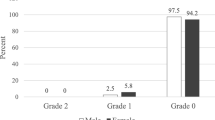Abstract
Objective
To assess the iodine status among primary school children of Dhankuta and Dharan in eastern Nepal.
Methods
A population based cross sectional study was conducted on schools of Dhankuta and Dharan from January–March 2008. 385 samples of both urine and salt were collected from school children aged 6–11 yrs. Urinary iodine excretion (UIE) was measured in casual urine samples by the ammonium-persulphate digestion microplate (APDM) method and salt iodine content by using a semi quantitative rapid test kit.
Results
The median UIEs of school children of Dhankuta and Dharan were 157.1 μg/L and 180.3 μg/L respectively. The percentage of iodine deficient (UIE <100 μg/L) children were 26.6% in Dhankuta and 15.6% in Dharan. The majority of children consumed packet salt. The percentages of salt samples with adequately iodized salt (≥15 ppm) were 81.3% in Dhankuta and 89.6% in Dharan.
Conclusions
Eastern Nepal is continuously progressing towards the sustainable elimination of iodine deficiency disease as illustrated by a normal median UIE and the majority of households consuming adequately iodized packet salt. It is necessary to maintain the program continuously to ensure adequate iodine nutrition of the population.
Similar content being viewed by others
References
Guttikonda K, Travers CA, Lewis PR, Boyages S. Iodine deficiency in urban primary school children: a cross-sectional analysis. Med J Aust. 2003;179:346–8.
Boyages SC. Iodine deficiency disorders. J Clin Endocrinol Metab. 1993;77:587–91.
Biswas AB, Chakraborty I, Das DK, Roy RN, Mukhopadhyay S, Chatterjee S. Iodine deficiency disorders among school children of Birbhum, West Bengal. Curr Sci. 2004;87:78–80.
Assessment of iodine deficiency disorders and monitoring their elimination. WHO/UNICEF/ICCIDD. WHO Publication 2007:1–108.
Joshi AB, Banjara MR, Bhatta LR, Rikimaru T, Jimba M. Assessment of IDD problem by estimation of urinary iodine among school children. Nepal Med Coll J. 2006;8:111–4.
Biswas AB, Chakraborty I, Das DK, Roy RN. Assessment of iodine deficiency disorders in Purulia district, West Bengal. Indian J Trop Pediatr. 2006;52:288–92.
Diosadyl LL, Vekatesh Mannar MG. Stability of iodine in iodized salt. In: Geertman RM, editor. 8th World Salt Symposium. Amsterdam: Elsevier; 2000. p. 977–82.
Baral N, Ramaprasad C, Lamsal M, Koner BC, Koirala S. Assay of iodine deficiency status in three ecological regions of Nepal by a micro digestion method. South East Asian J Trop Med Public Health. 1999;30:527–31.
Ohasi T, Yamaki M, Pandav CS, Karmakar MG, Irie M. Simple microplate method for determination of urinary iodine. Clin Chem. 2000;46:529–36.
Nepal Micronutrient Status Survey 1998. Kathmandu Nepal: Ministry of Health, Child Health Division, HMG/N, New ERA, Micronutrient initiative, UNICEF, Nepal and WHO.
Nepal Iodine Deficiency Disorders status survey 2005. Kathmandu, Nepal: Ministry of Health and Population, Child Health Division. The Micronutrient Initiative and New ERA.
National Survey and Impact Study for Iodine Deficiency Disorders (IDD) and availability of iodized salt in Nepal 2007. Kathmandu, Nepal: Ministry of Health and Population, Department of Health Services, Government of India and Alliance Nepal.
Gelal B, Aryal M, Lal Das BK, Bhatta B, Lamsal M, Baral N. Assessment of iodine nutriture among the primary school children of Nepal by urinary iodine assay. South East Asian J Trop Med Public Health. 2009;40:538–43.
Sarkar S, Mohanty B, Basu S. Iodine deficiency in school going children in Pondicherry. Indian J Pediatr. 2007;74:731–4.
McDonnell CM, Harris M, Zacharin MR. Iodine deficiency and goitre in Melbourne, 2001. Med J Aust. 2003;178:159–62.
Baral N, Lamsal M, Koner BC, Koirala S. Thyroid dysfunction in Eastern Nepal. South East Asian J Trop Med Public Health. 2002;33:638–41.
Acknowledgements
We gratefully acknowledge the cooperation of children, their parents and teachers of all school of Dhankuta and Dharan.
Author information
Authors and Affiliations
Corresponding author
Rights and permissions
About this article
Cite this article
Gelal, B., Chaudhari, R.K., Nepal, A.K. et al. Iodine Deficiency Disorders Among Primary School Children in Eastern Nepal. Indian J Pediatr 78, 45–48 (2011). https://doi.org/10.1007/s12098-010-0239-2
Received:
Accepted:
Published:
Issue Date:
DOI: https://doi.org/10.1007/s12098-010-0239-2




